If you’ve ever wondered about the buzzwords dominating tech conversations—artificial intelligence (AI), machine learning (ML), and deep learning (DL)—you’re not alone. These terms are often tossed around interchangeably, but they’re not the same. Whether you’re a beginner dipping your toes into tech, an enthusiast eager to explore, or a professional looking to sharpen your skills, this guide breaks it all down in a way that’s easy to grasp and exciting to dive into. Let’s unravel the differences between AI, ML, and DL, explore their real-world applications, and peek into their future—all while spotlighting an upcoming learning opportunity you won’t want to miss.
What Are AI, Machine Learning, and Deep Learning?
Artificial Intelligence (AI): The Big Picture
AI is the granddaddy of them all—a broad field aiming to create machines that mimic human intelligence. Think of it as the umbrella term covering any technology that enables computers to think, learn, or act like humans. From solving problems to making decisions, AI is about building “smart” systems. It’s been around since the 1950s, when pioneers dreamed of machines that could play chess or translate languages.
Key Trait: AI is the overarching goal—making machines intelligent. It includes everything from simple rule-based systems to advanced algorithms.
Machine Learning (ML): The Smart Student
Machine learning is a subset of AI, focusing on systems that learn from data without being explicitly programmed. Imagine teaching a child to recognize cats: instead of describing every feature, you show them pictures and let them figure it out. ML works similarly—feeding data into algorithms that spot patterns and make predictions.
Key Trait: ML thrives on data. The more it “sees,” the smarter it gets. It’s less about human rules and more about self-improvement.
Deep Learning (DL): The Brain Mimic
Deep learning is a specialized branch of ML inspired by the human brain. It uses neural networks—layers of interconnected “neurons”—to process massive amounts of data, uncovering complex patterns. If ML is a student, DL is the prodigy tackling intricate tasks like understanding speech or identifying faces.
Key Trait: DL excels with unstructured data (like images or audio) and needs hefty computing power to shine.
How Are AI, ML, and DL Different?
Here’s the simplest way to picture it: AI is the whole toolbox, ML is a powerful tool inside it, and DL is an even sharper, more advanced version of that tool. Let’s break it down further:
- Scope: AI is the broadest, encompassing any intelligent system. ML narrows it to data-driven learning, while DL zooms in on neural networks.
- Complexity: AI can be as basic as a chatbot following if-then rules. ML steps up with algorithms like decision trees, and DL goes all-in with multi-layered neural networks.
- Data Dependency: General AI might not need data (think rule-based systems), ML needs good datasets to learn, and DL demands huge datasets plus serious computing muscle.
- Human Input: AI often relies on human-defined logic. ML reduces that need by learning patterns, and DL takes it further, automating feature detection.
In short, they’re a family: AI is the parent, ML the child, and DL the brilliant grandchild pushing boundaries.
Real-World Applications: AI, ML, and DL in Action
Seeing these concepts at work makes them less abstract. Here’s how they show up in your daily life:
AI in Action
- Virtual Assistants: Siri, Alexa, and Google Assistant use AI to understand commands, set reminders, or play your favorite tunes. They combine rule-based logic with smarter subfields like ML.
- Self-Driving Cars: Tesla’s Autopilot blends AI to navigate roads, avoid obstacles, and make split-second decisions.
Machine Learning Applications
- Recommendation Systems: Netflix and Spotify use ML to analyze your viewing or listening habits, suggesting shows or songs you’ll love.
- Fraud Detection: Banks rely on ML to spot unusual transactions, flagging potential scams in real time.
Deep Learning Explained with Examples
- Image Recognition: DL powers facial recognition on your phone or tags friends in photos on social media.
- Voice Processing: Tools like Google Translate use DL to convert spoken words into text or other languages with uncanny accuracy.
These examples show how each builds on the others—AI sets the stage, ML refines it, and DL takes it to the next level.
The Future Scope of AI, ML, and DL
The horizon for these technologies is thrilling—and a little mind-boggling. Here’s what’s coming:
- AI’s Evolution: Expect AI to integrate deeper into healthcare (think diagnostics), education (personalized learning), and even creative fields (AI-generated art). General AI—machines that think like humans—remains a distant dream, but we’re inching closer.
- ML’s Growth: Machine learning will fuel smarter automation, from supply chain optimization to climate modeling. Its accessibility is booming, with tools making it easier for non-experts to jump in.
- DL’s Frontier: Deep learning is set to revolutionize fields like natural language processing (NLP) and computer vision. Imagine flawless real-time translation or robots that “see” as well as we do. Efficiency is key, with trends like smaller, energy-saving models gaining traction.
The demand for skills in these areas is skyrocketing—making now the perfect time to dive in and learn.
Level Up with Deep Learning & NLP: A Learning Opportunity
Want to master these cutting-edge fields? Check out the upcoming Edegree in Deep Learning & NLP from Eduonix, launching in April 2025. This online course, dives deep into neural networks, language processing, and real-world applications—perfect for beginners and pros alike. Preorder now to lock in early access and start building skills that employers crave. Don’t wait—your future in tech starts here!
Wrapping Up: AI vs. ML vs. DL Made Simple
So, what’s the difference? AI is the grand vision of intelligent machines, ML is the data-driven engine making them smarter, and DL is the brain-like powerhouse tackling complex challenges. Together, they’re transforming our world—from the apps on your phone to the cars on the road. As they evolve, the opportunities for learning and innovation are endless.
Ready to explore more? Preorder the Edegree in Deep Learning & NLP today and get a front-row seat to the future of tech. Which of these fields excites you most—AI, ML, or DL? Let us know in the comments!





